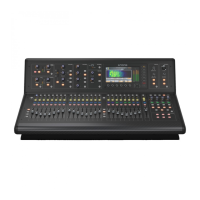66 M32 - Digital Console User Manual 67
4. Tap the fourth control to assign the selected output path, completing the process.
5. Adjust the fth control to select the signal tap point for the output assignment. This determines where in the audio
signal path the source is ‘tapped’ as it is sent to the P16 output. The available signal tap points include:
• Input
• Pre-EQ
• Pre-Fader
• Post-Fader.
6. Tap the fth control to complete the signal tap point assignment.
card out
The ROUTING screen’s card out tab allows the user to patch various signal paths to the physical inputs and outputs on the
XUF card. The XUF’s signal path provides 32 channels of inputs and 32 channels of outputs. The 32 card inputs can be used
as alternative sources for the two input fader layers, switchable in banks of eight.
To assign an output path to the option card, perform the following steps:
1. Adjust the rst rotary control to select an 8-channel signal path that will be sent to the rst eight channels of the
card. Choices include:
• Local 1-8 • AES50-B 25-32
• Local 9-16 • AES50-B 33-40
• Local 17-24 • AES50-B 41-48
• Local 25-32 • Card 1-8
• AES50-A 1-8 • Card 9-16
• AES50-A 9-16 • Card 17-24
• AES50-A 17-24 • Card 25-32
• AES50-A 25-32 • Out 1-8
• AES50-A 33-40 • Out 9-16
• AES50-A 41-48 • P16 1-8
• AES50-B 1-8 • P16 9-16
• AES50-B 9-16 • Aux 1-6/Mon.
• AES50-B 17-24
2. Tap the rst control to assign the selected output path, completing the process.
3. Repeat the process with controls 2-4 to select output paths for the other 24 channels or card outputs.
aes50-a / aes50-b
The ROUTING screens aes50-a and aes50-b tabs allow the user to patch various console output paths to the outputs
of the dual AES50 connectors. These connectors can feed other AES50-equipped devices, such as a digital stage box or
standalone multi-track recorder.
The M32 contains two separate AES50 connectors, labelled A and B. These dual connectors allow for an increased level of
exibility in networking the console to various AES50-based equipment.
Each of the two AES50 tabs contains the same following sets of parameters that can be adjusted. To assign various
console signal paths to the AES50 connectors, perform the following steps:
1. Adjust the rst rotary control to select an 8-channel signal path that will be sent to the rst eight channels of the
AES50 connector’s output. Choices include:
• Local 1-8 • AES50-B 25-32
• Local 9-16 • AES50-B 33-40
• Local 17-24 • AES50-B 41-48
• Local 25-32 • Card 1-8
• AES50-A 1-8 • Card 9-16
• AES50-A 9-16 • Card 17-24
• AES50-A 17-24 • Card 25-32
• AES50-A 25-32 • Out 1-8
• AES50-A 33-40 • Out 9-16
• AES50-A 41-48 • P16 1-8
• AES50-B 1-8 • P16 9-16
• AES50-B 9-16 • Aux 1-6/Mon.
• AES50-B 17-24
2. Tap the rst control to connect the currently selected signal path to the AES50 pathway.
3. Repeat the above process for the other ve sets of 8-channel AES50 outputs.
The aes50-b tab works exactly the same as the aes50-a tab, but instead selects sources sent to the output of the console’s
AES50-B connector.
www.theaudiospecialists.eu

